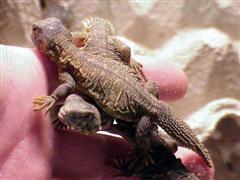Agama - Flying Dragon
Flyng Lizard, Flying Draco Scientific Name: Draco volan
Mon, 28th April, 2025 - 9:45 am GMT
Sponsor Ads:

Alternative Name
Flyng Lizard, Flying Draco Scientific Name: Draco volanBasic Info
Flying Dragons have low, long bodies. They have flaps of skin along the ribs, which can be extended into "wings" by the lizard elongating its ribs. They have a dewlap, or gular flap, which can also be extended. Generally, Flying Dragons grow to a little less than 12 inches in length. Although females are usually larger than males, their dewlaps are a bit smaller. In color, Flying Dragons are brown and have bluish coloration on the undersides of their wings and a yellow colored dewlap. Females tend to have bluish dewlaps and yellow coloring on the wings' undersides. Their heads are blunted and fairly short, and each leg has five clawed toes.
Health
Flying Dragons need a humidity level over 75 percent. Their daytime temperature should remain between 80 and 85 degrees Fahrenheit with a ten-degree nighttime drop. The basking spot should be between 90 and 95 degrees. You can feed your Flying Dragon mealworms and crickets, dusted with a vitamin supplement, several times a week. They should always have a bowl of water available to them, and they appreciate a daily misting. Breeding In the wild, Flying Dragons probably mate between December and January. The courtship involves male Flying Dragons circling the females while displaying their extended gular flaps and wings in addition to bobbing their bodies up and down. Eggs are laid in a nest that the female creates by digging a small hole in the ground with her head. Usually, a clutch contains five eggs and the female will tamp the ground back over the completed nest with her head. The female Flying Dragon guards her nest for about 24 hours, and then abandons it. The eggs will need about 32 days to incubate and miniature versions of adult Flying Dragons will emerge.Habitat
Southwest tropical forests of Asia and India, including Borneo and the Philippine Islands.Behavior
Perhaps you have heard stories of flying dragons. These stories find a bit of reality, but also more myths, in the Flying Lizard. Flying Lizards, or Flying Dragons, do not really fly; rather, they jump from trees and glide. These interesting lizards are also known as Flying Dracos and may be kept as pets. In the wild, the Flying Dragon will generally claim a territory. Usually, males will mark two or three tree as their own, and one to three female Flying Dragons will live in each tree. When the male Flying Dragon meets another animal, he may extend his dewlap partially or fully, extend his wings partially or fully, perform a combination of dewlap or wing extension, or bob his body up and down. If he meets a female, he may circle her. Extending the wings and dewlap makes the Flying Dragon appear larger, and he will usually exhibit such behavior if he feels threatened. In order to move from one place to another, Flying Dragons will spread the skin flaps along their abdomens and glide out of trees or from other high areas. They never glide when it is raining or when it is windy. When the Flying Dragon is about to take off, it will point its head toward the ground. Usually, Flying Dragons are diurnal and hide in the late morning and early afternoon to avoid the most intense sunlight of the day. In captivity, they will need a well-lit terrarium with hiding places. These lizards will best thrive in large enclosures containing well-established plants. Their terrarium should be tall, as the Flying Dragon is arboreal, and at least 25 gallons in size. Although these lizards are very lovely, especially in "flight", it is probably best not to handle them too much. They are a bit shy and can become stressed easily.Origin
Indo-PacificHistory
The Flying Dragons are difficult to catch for the pet trade because they are so fast and agile by adulthood. Flying Lizards are native to the southwest tropical forests of Asia and India, including Borneo and the Philippine Islands.Common Foods
Flying Dragons eat insects. They catch such prey by sitting under a tree until an insect passes by, and then they eat it. In captivity, Flying Dragons will do well when fed on worms, flies, crickets, wax worms, or ants.Sponsor Ads:
A fellow who is always declaring that he is no fool usually harbors suspicions to the contrary. -- Unknown
Agama - Flying Dragon
Coded by: BGID® | ALL RIGHTS RESERVED Copyright © 2000-2025
Disclaimer | Privacy | Report Errors / Contact | Credits
















